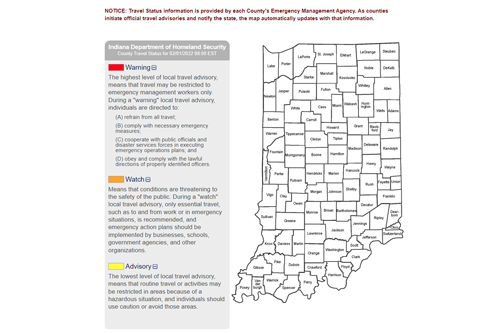Winter Storms
- Get Prepared
- Nature Safety
- Current: Winter Storms
Every winter may not be as severe as predicted, but weather can change quickly. Preparation is key to Hoosiers staying safe for whatever the winter weather may throw at them.
Travel Advisories
Winter storms can create dangerous travel conditions and prompt counties across Indiana to issue local travel advisories. These advisories are shown on the IDHS county travel status map. Many state agencies, private sector partners and non-governmental organizations rely on the map to make safe decisions during winter storms. Counties decide whether to issue travel advisories, watches or warnings, and the map updates in real time when a county emergency management agency reports its county's updated travel status to the state. Be sure to check the map before hitting the road when winter storms are expected.
Winter Storm Safety Tips
Quick Tips
- Before use, have your fireplace or wood stove cleaned to avoid carbon monoxide poisoning.
- Stock up on non-perishable food and water in the event of a power outage or being snowed in.
- Know how to shut off water valves properly if a pipe were to burst due to extreme cold.
- Make sure to prepare for emergencies that may arise while traveling in winter weather by having a vehicle emergency kit ready.
- Obey speed limits. If driving significantly below the speed limit, turn on the vehicle's hazard lights.

Indiana Local Travel Advisory Statuses
Source: Indiana Code 10-14-3-29.5
- Advisory: The lowest level of local travel advisory means that routine travel or activities may be restricted in areas because of a hazardous situation, and individuals should use caution or avoid those areas.
- Watch: Means that conditions are threatening to the safety of the public. During a "watch" local travel advisory, only essential travel, such as to and from work or in emergency situations, is recommended, and emergency action plans should be implemented by businesses, schools, government agencies and other organizations.
- Warning: The highest level of local travel advisory means that travel may be restricted to emergency management workers only. During a "warning" local travel advisory, individuals are directed to:
- (A) refrain from all travel;
- (B) comply with necessary emergency measures;
- (C) cooperate with public officials and disaster services forces in executing emergency operations plans; and
- (D) obey and comply with the lawful directions of properly identified officers.
National Weather Service Alerts
Source: National Weather Service
- Advisory: Winter weather advisories are issued when snow, blowing snow, ice, sleet or a combination of these wintry elements is expected, but conditions should not be hazardous enough to meet warning criteria. Be prepared for winter driving conditions and possible travel difficulties. Use caution when driving.
- Watch: Winter storm watches are issued when conditions are favorable for a significant winter storm event (heavy sleet, heavy snow, ice storm, heavy snow and blowing snow or a combination of events).
- Warning: Winter storm warnings are issued for a significant winter weather event including snow, ice, sleet or blowing snow, or a combination of these hazards. Travel will become difficult or impossible in some situations. Delay travel plans until conditions improve.
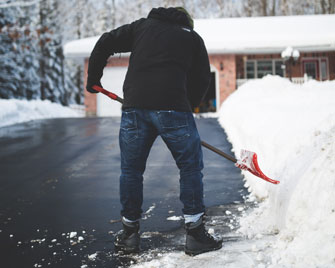
For the Home
Someone does not have to be outside to be affected by winter weather. Staying safe while indoors is important too.
- Monitor local radio, TV stations and social media websites for weather updates.
- Create an emergency preparedness kit.
- Stock up on non-perishable food and water in the event of a power outage or being snowed in.
- Make sure the house is well-insulated to avoid the need of an alternative heat source.
- If alternative heat sources are needed, follow the manufacturer’s instructions and always turn them off before going to bed or leaving home.
- Keep a fire extinguisher on hand in the event of a fire due to cooking or an alternative heating source.
- Know how to shut off water valves properly if a pipe were to burst due to extreme cold.
- Bring pets indoors or ensure they have a warm shelter area with unfrozen water.
- Take breaks often when shoveling snow. Approximately 100 people die every year from heart attacks they endured while shoveling snow.
- Change into dry clothes after outdoor activities to prevent frostbite.
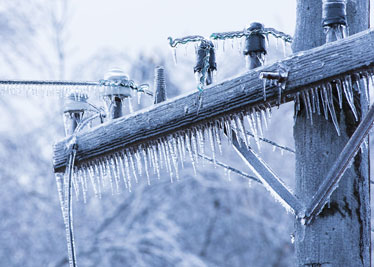
Power Outages
Winter weather can impact electric utilities. If the power goes out, it is important to follow these tips until professionals can make repairs.
- Notify the electric utility company right away.
- Gather everyone in the most insulated and interior room available.
- Turn off and unplug most electronic devices to avoid a power surge. Leave one light on to know when the power has been restored.
- Before use, have your fireplace or wood stove cleaned to avoid carbon monoxide poisoning.
- Check travel conditions before determining if evacuation is necessary. If leaving the home, take medications and other must-need items, along with extra clothing, to a friend or family member’s house, or a nearby shelter.
- Consider taking the time to check on neighbors, especially those with medical conditions.
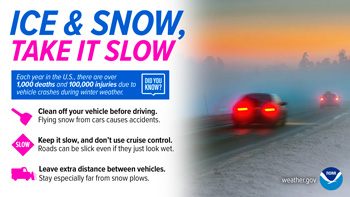
Driving in Winter Weather
Driving during winter weather should be avoided as much as possible. However, when it cannot be, follow these tips to stay safe.
- Fill a vehicle’s gasoline tank before a winter storm because the fuel will have a lower chance of freezing.
- Before cold weather hits, mechanics should check the vehicle’s brakes, heater, defroster, tires and windshield wipers.
- Create an emergency preparedness kit for each vehicle.
- Always wear a safety belt.
- Obey speed limits. If driving significantly below the speed limit, turn on the vehicle's hazard lights.
- Avoid using cell phones and never text while driving.
- If stranded, do not exit the vehicle to find help unless it is within 100 yards.
- Display a bright piece of clothing to signal for help if stranded.
- Floor mats can be used for extra insulation.
- To prevent carbon monoxide poisoning, never run a vehicle stuck in the snow more than 10 minutes each hour, and make sure the tailpipe is not blocked.
For more information, visit the Winter Vehicle Safety page.
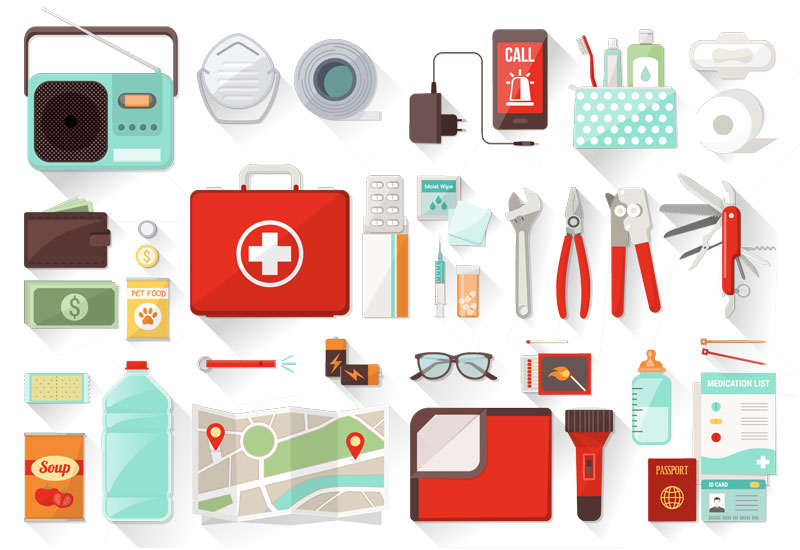
Winter Vehicle Emergency Kit
Make sure to prepare for emergencies that may arise while traveling in winter weather by having a vehicle emergency kit ready.
- Bag of sand or cat litter (for better tire traction)
- Blankets or a sleeping bag
- Cash
- First aid kit
- Flashlight and extra batteries
- Ice scraper and snow brush
- Jumper cables
- Maps
- Non-perishable, high-protein food
- Portable phone charger
- Road flares
- Shovel
- Spare clothes, mittens, scarves and hats
- Water
- Weather radio
Resources
Websites
- Extreme Cold
Indiana Department of Homeland Security - How to Prepare for a Winter Storm
Ready.gov - Snowstorms and Extreme Cold
Ready.gov - Winter Weather Warnings, Watches and Advisories
NOAA
Travel Advisories
The Indiana Department of Homeland Security State Emergency Operations Center (SEOC) hosts the county travel status map. Counties decide whether to issue travel advisories, watches or warnings, and the SEOC produces advanced weather summaries and assessments from its Watch Desk to inform county emergency management agency directors, who advise their county commissioners on making these local travel status decisions. When a county emergency management agency reports its county's updated travel status to the state, the change is reflected on the map.
Many state agencies, private sector partners and non-governmental organizations rely on the map to make safe decisions, especially during winter weather conditions. For example, the Indiana National Guard uses the map during times of flooding or heavy snow to help plan its routes through the state.

